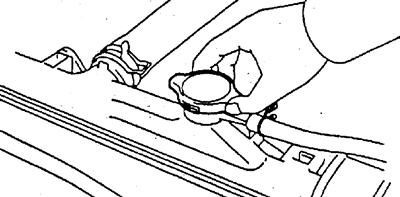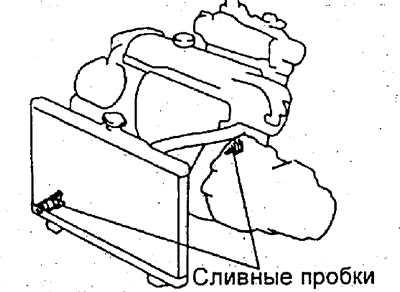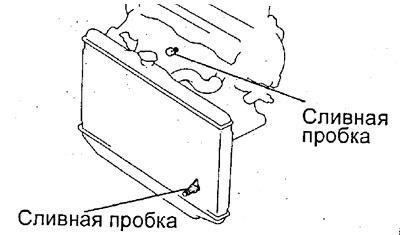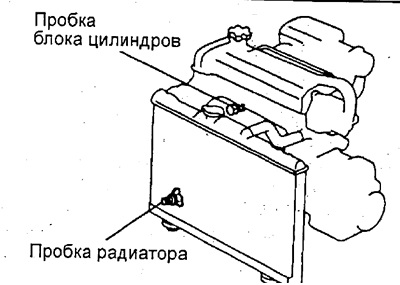The coolant level on a cold engine must be between the marks "LOW" And "FULL" on the wall of the expansion tank.
If low, check for leaks and add coolant to the mark "FULL" (warm engine) and labels "LOW" (cold engine).

2. Check the quality of the coolant.
A) Remove the radiator cap.
Caution: To avoid burns, do not remove the radiator cap while the engine is hot, as fluid and vapor are under pressure.

b) There should be no excessive rust deposits around the radiator cap valves or radiator filler seats. The coolant must be clear and free of oil.
If the coolant is dirty, clean the channels of the cooling system and replace the liquid.
V) Install the radiator cap.
3. Replace coolant.
A) Remove the radiator cap.
Note: Be careful when removing the plug from a hot engine.
b) Drain the coolant by removing the radiator and engine drain plugs.
V) Apply sealant to two or three threads of the drain plugs and tighten them.

2C

3S-FE, 4S-FE

4A-FE

7A-FE
G) Slowly pour coolant into the cooling system in an amount corresponding to the filling containers..
Note:
- Use a good brand of ethylene glycol based coolant and mix according to the manufacturer's instructions.
- It is recommended to use a coolant that contains more than 50% ethylene glycol, but not more than 70°%.
- Do not use alcohol antifreeze.
- The coolant must be mixed with demineralized water or distilled water.
Filling capacities:
(until 08.1994)
2С - 7.0 l
3S-FE, 4S-FE - 6.0 L
4A-FE, 5A-FE
- models with manual transmission - 5.4 l
- models with automatic transmission - 5.3 l
(from 08.1994)
2С - 7.0 l
3S-FE
- models with manual transmission - 6.6 l
- models with automatic transmission - 7.0 l
4A-FE, 5A-FE
- models with manual transmission - 5.4 l
- models with automatic transmission - 5.3 l
7A-FE
- models with manual transmission - 5.6 l
- models with automatic transmission - 5.5 l
d) Install the radiator cap.
e) Warm up the engine and check for leaks.
and) Check the coolant level and top up if necessary.
